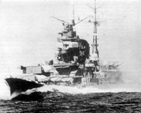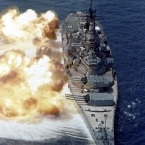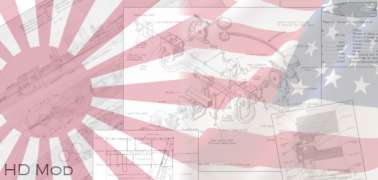John 3rd
Posts: 17178
Joined: 9/8/2005
From: La Salle, Colorado
Status: offline

|
Taken from the AAR Thread:
The Reluctant Admiral is a Japanese 'what if' scenario based upon a greater contribution by Adm. Yamamoto Isoroku. The premise of the Mod is that Yamamoto exerted a much greater influence first on the Japan Naval Aircraft Industry, then as Deputy Navy Minister, and finally as Navy Minister itself. Yamamoto chooses, at great risk to his life, to forego command of the Combined Fleet and dedicate himself to preparing Japan for a war he didn't want.
In choosing to do this Yamamoto changes the 4th Circle Building plan replacing the 3rd and 4th Yamato-Class Battleships with improved Shokaku-Class CVs and a pair of fast Battlecruisers. Other warships are added as planned within 4th Circle. The Japan Naval Air Arm is changed so that everything is staked to the Zero Airframe with a specialization of the Zero into a Land-Based Interceptor as well as CV-Based Fighters. Additional engineers and engineering vehicles are added to Naval Units better reflecting Yamamoto's foresight into base building and expansion needs. New and expanded Naval Yards, Heavy Industry, and Armaments are added at tremendous cost for the Japanese economy.
Very little is changed in the opening of the Scenario (based on Scenario 1) except for a few more aircraft and 3 warships. The foresight of the Admiral will payoff during 1942 and early-1943 as new ships and aircraft enter into the Japanese Order-of-Battle.
How well can YOU do to use these new tools OR how well can you stop the Japanese Navy in its tracks as the Allies.
(Designer's note: Production is 'on' for this scenario)
Scenario Designers: Stanislav Bartoshevitch (FatR), Michael Benoit (NY59Giants), John R. Cochran, III (John 3rd), Juan Gomez (JuanG), Ben Kloosterman (BK), and John Young (Red Lancer)
For those who haven't followed the Design of the Mod, let me mention the work done by everyone to get it ready to go:
FatR--Chief of Aeronautics focused mainly on the new and modified Aircraft. He also helped in finding a number of bugs within the 'test' versions of the Mod.
Michael--Provided an Allied perspective and made sure there was a little 'something' in this for the Allies. He also served as an excellent sounding board.
JuanG--Held my hand in the design process and truly was a major help for ideas, comments, and proposals. Many of them made their way into the Mod. Should mention some of his ship art is in this for the Kawachi-Class BCs and few other vessels.
BK--Massively helped in the air development and deisgn area with FatR. He must have 150-200 Posts in the two Design Threads. Invaluable help and suggestions flowed through him.
Red Lancer--Provided VERY NICE new aircraft art for at least a dozen or so planes. They are PERDY!
Damian--Perhaps he should be mentioned too for his checking of the revamped Japanese economy by use of Tracker. Very helpful.
This Mod started back over in WitP when Alikchi (he deserves a big thank you as well) and I got into a heavy discussion of the 4th Circle Plan. From that discussion I did a bunch of reading on Admiral Yamamoto and was struck by the foresight he had in seeing many issues facing Japan. Many of us know this in the general history but few have actually read what he said and/or wanted to do. This scenario reflects many of his wishes as shown in 2-3 of his biographies and Kaigun.
It has been fun designing this creation. I am NOT a Computer person! My wife Paula and friend Michael (my aide and opponent) will testify to that. The creators of AE deserve magnificent credit for the Editor they have brought to life. It is intuitive and easy-to-use (relatively). Even with this said the Mod could not have been created without those mentioned above and the dozens who contributed their thoughts to the scenario.
This is FatR's Commentary:
This scenario assumes, that with Yamamoto assuming the position of the Aeronautics Department's head in 1936 and becoming the Naval Minister later, he intensifies Japanese naval aviation development a bit, and attempts to optimize the utilization of limited engineering and production resourses. Chief engineers of aircraft design teams are given slightly greater input in formulating development directions and cooperation between various aircraft manufacturers is assumed to be somewhat improved.
In particular, the concept of dedicated land-based interceptor is abandoned and the Mitshubishi fighter design team under Jiro Horikoshi remains free to concentrate all of its efforts on modifying A6M and creating its successor A7M. Horikoshi's proposal to install the more powerful Mitsubishi Kinsei engine on Zero is approved in 1942, instead of late 1944, and A7M is developed to use Mitsubishi Ha-43 engine, as he desired, from the beginning. A6M3 is developed into a whole line of Zeros that sacrifice range in favor of superior armament and pilot protection, and eventually are officially designated as pure land-based models. IJN maintains the policy of sticking to just one single-engine fighter airframe, until Kawanishi team develops N1K1-J Shiden as a private initiative (this happens slighltly earlier than in RL, because alternate projects of land-based interceptors, that tied Kawanishi resourses, do not exist). It is adopted as a stopgap measure until availability of A7M.
As a side effect of greater effort put into development and production of Mitsubishi Kinsei (Ha-33) and Mitsubishi Ha-43 engines, several planes that historically used these engines are added to the mod (if they existed only as prototypes by the war's end), or accelerated.
Aircraft weapon development is streamlined, with a push for unification with IJAAF in this area (historically, IJN and IJA did cooperate in aircraft weapon production, in this scenario their cooperation becomes much broader). Instead of attempts to produce licensed German machine guns, that ultimately failed to provide the fleet with sufficient numbers of them, IJN switches to the more powerful Army 7.7 catridge and eventually adopts 12.7 Ho-103, the first aircraft HMG developed in Japan. This allows for improved armament on some planes, mostly 2E bombers.
This scenario also assumes mild overall boost to Japanese aircraft industry (at the cost of reduction in starting resources). As a result, several planes that historically faced severe problems with transition from prototypes to mass production, such as B6N, D4Y and G4M2, become available a bit earlier. G8N1, the Japanese 4E bomber that was successfuly tested but not mass-produced in real life, becomes available in 1945.
In addition, there are many minor tweaks to various aircraft, intended to make their statblocks and performance closer to historical. The changes that can affect gameplay most noticeably include:
-Early Japanese fighters (Ha-35 Zeros and Ki-43) have their high-altitude MVR reduced.
-G4M has slightly better durability, G3M sligtly worse, to give G4M an edge over the older plane it historically had.
-E16A1 Paul no longer has artificially reduced normal range.
-Ki-44 uses Nakakima Ha-34 engine, instead of Ha-35, for historical accuracy.
-Late Ki-61 versions are slightly improved. Ki-100s are significantly improved. In RL they were supposed to be good, particularly Ki-100, but in AE they are very underwhelming.
-Ki-67-Ib does not lose the ability to carry torpedos.
-Old Russian fighters no longer have unparalelled MVR. Their clear superiority to Nate has to go.
Following aircraft were added to this scenario (all but new Zeros and G3M4-Q existed in RL as prototypes or even production models):
-A6M3b Zero. Replaces A6M3a and emphasized armor and weapons instead of range.
-A6M4, A6M4-J, A6M8-J. Successors to A6M3b that follow the same design philosopshy but use Mitshubishi Ha-33 engine.
-A7M3. The historical successor to A7M2. Carrier-capable and features 6x20mm armament. A7M2 factory upgrades to it, instead of A7M3-J.
-B7A3. The historical armored successor to B7M2. Uses Mitsubishi Ha-43 engine.
-D4Y5. Mitshubishi Ha-43, armor. D4Y3 upgrades to it. (D4Y4 was a kamikaze plane in RL.)
-G3M4-Q. ASW patrol version of Nell.
-G8N1. Fast, tough, long-ranged 4E bomber.
-J6M1. IJN version of Ki-83.
-N1K4-A. Carrier-capable Shiden.
-N1K5-J. High-altitude interceptor Shiden. Uses Mitsubishi Ha-43 engine.
-Yasukuni. IJN version of Ki-67. "Yasukuni" might actually be the name of the naval unit, that employed these bombers in RL, but I can't find any other designation for them.
Response to several comments at the start of the AAR:
Actually Jeff they knew a great deal about the possible 4th Circle Planning. Many thought there was a 3rd Sho-Class CV and they planned and built the Alaska's to counter the Kawachi's. In no way, shape, or form is this an extreme Mod. That is part of the reason I based it on Scenario 1. This is NOT a JFB Mod in any form of extreme. There are new fighters based on the Zero but NO JACKS which is superior to many of the planes we introduce. The trade-off is some of the earlier models come in early and the later-models have a somewhat more rugged build for less range and speed.
As to ships, the useless Shinano is not planned and the excellent Taiho and her two possible sisters are cancelled. The Japanese gain about 24 new possible DDs in the form of Yugumo-Class and Akizuki-Class. These were all planned but not completed within 4th Circle. Yamamoto does get the Shipyards to specialize some allowing for the production times of DDs to shrink by an average of 3-5 months. Kaigun spends some considerable time on that topic. Two additional Tone-Class CAs are ordered as planned (did make them Tone Clones instead of a new class). The Agano's don't have the design argument that paralized them from nearly 24 months and the additional slipways allow for them to be built in roughly pairs. Oyodo and Niyodo come in as the 5th and 6th Agano's as they should have.
The Scenario is not fantasy like some of Juan's or others. While a heck of a lot of fun (witness Michael and I's Shipwreck AAR) those are pretty darned extreme. I hoped for and think we have delivered a plausible scenario that adds some things but also doesn't upset the end-game whatsoever. For every expansion and/or addition caused Supply and Fuel to be deducted from Japan's starting stockpile. The Empire comes in slightly better prepared but with a more pressing need to grab oil and resources INTACT ASAP.
Another important note is that these changes are split about 90% for the IJN and 10% for the IJA. The Army's OOB doesn't hardly change whatsoever.
Lastly, the Allied players does get a few little tidbits thrown into their lap such as more recon assets and additional ground/air units in the SE Pacific.
Juan's Additions:
Changes were made to the following areas; submarine torpedo tubes, ship ammo loadouts, naval gun accuracy and penetration, certain weapon classifications, and mine production.
The changes in each area are as follows;
Submarine Torpedo Tubes
By using the torpedo tube arrangements courtesy of JWE from the DB mod, submarines are able to take advantage of the changes to the submarine torpedo firing routines introduced in Patch 3. These allow a submarine to fire variable numbers of torpedo devices at a target, meaning that submarines will fire more torpedoes at high value targets, and less at DDs and other small vessels.
Ship Ammo Loadouts
Regular AE scenarios use roughly 10% of the RPG (Rounds Per Gun) value for naval guns to determine the ammo loadout, with adjustments made for DP weapons. This however, especially in light of the naval gun accuracy changes made in Patch 2, meant that large caliber weapons would commonly expend all their ammo during a single engagement, whereas this was almost unheard of in the war. The changes made involve a recalculation of the database ammo values based on both RPG and rate of fire, again adjusting for DP weapons. The net effect has been an increase in available ammo, though certain ships - mostly British and Japanese DDs, do suffer from this slightly. Light AA ammo has also been adjusted upwards in most cases.
Naval Gun Accuracy and Penetration
Some adjustments to the accuracy of certain guns has been made, the most notable being the increases made to the 10cm/65 and the 8cm/60 Japanese DP weapons, and the slight decrease to the early (Model A and B) 12.7cm/50 Japanese guns. Minor changes were also made to penetration values for naval guns 8in and greater.
Naval Gun Classifications
The IJN DDs have been assigned their correct Model of 12.7cm/50 mounts, rendering over half of them incapable of using their primary battery as a DP weapons. The USN 5in/54 Mk 16 mount has also been reclassified as a DP weapon, to reflect the high angle nature of this weapon.
Mine Production
The rate of production for all mines from all navies has been increased to twice that of regular AE.
A Little about the Changes:
The Reluctant Admiral starts with the Imperial Fleet slightly better prepared at the start of the war and progressively getting stronger throughout 1942 to peak strength in 1943.
Ground--The Imperial Fleet ground forces have several additions that include Engineers and Engineering Vehicles. The additions are based on the unit's size: an IJN Con Bat gains 12 Engineers and 2 Eng Vehicles while a large HQ Unit got 48 Engineers and 10 Vehicles. No additional combat firepower has been added whatsoever.
In a differing departure from the above, we did choose to add the German 88mm AA gun to several Japanese AA units. Most are in the Home Islands with a few spread around in Formosa, Saigon, and Truk.
Air--The only changes to the Japanese OOB at the start is that all Claudes have been upgraded to Zero, the CVs Air Groups filled out, and all CV Torpedo planes are Kates. About 80 planes are added in total here.
Naval--The 4th Circle is only just getting started so the Japanese gain the new Agano and Noshiro as well as Shoho.
Things noticed with Turn One sent:
Since others are getting the files I thought I should write some Scenario Observations that will help for the Mark 2 Version of the Mod. Notes:
1. With TF that I moved I forgot to change their destinations. So you might see that DD TF at Truk but it says its destination is Ominato. There are several TF like that.
2. CV Placement and Organization:
a. The KB is divided into two TF at their starting Northern Base. Both TF have the first Turn movement bonus. Moved the other pair of BC up there as well as five DDs. The two new CLs are present as well. The player now has the ability to strike two targets Pearl and Manila/Singapore if they wish. Make sure some sort of House Rule is written covering this. The 6 CV start with their Air Group complements full.
b. The Mini-KB (CarDiv3)has Ryujo (48 Planes), Zuiho (30 Planes), and the new Shoho (30 Planes) start at Babeldoap. Biggest thing I noticed about this group is that they have an abundant amount of Zeros (28-21-21) and some punching power (36 Kates). This trio would provide excellent Invasion Force protection with all those Zeros. They have 1st Turn move bonus.
c. The two CVE (Taiyo and Hosho) are also at Babeldoap with small planes complements aboard. Hosho has 12 Zero and 6 Kate while Taiyo has 9 Zero and 12 Vals. They do not have the turn bonus but can be used for a variety of purposes.
3. The 6 Japanese BB begin spread out to support the Invasions. Since two BC were pulled to be in a more appropriate place (with the CVs), Nagato and Mutsu begin in Malaya. Two BBs are at Cam Rahn Bay and the final set begins at Babeldoap. Big guns should be able to be brought to bear at multiple points from the start.
4. Had some brain problems when I redeployed units. Managed to reassign them to their appropriate HQ Commands and bases but managed to forget their prep targets. You've got several units in Ominato assigned to 5th Fleet but prepping for the DEI. Ooppps.
That places almost everything pertinent into this Thread.
_____________________________
|
 Printable Version
Printable Version










 New Messages
New Messages No New Messages
No New Messages Hot Topic w/ New Messages
Hot Topic w/ New Messages Hot Topic w/o New Messages
Hot Topic w/o New Messages Locked w/ New Messages
Locked w/ New Messages Locked w/o New Messages
Locked w/o New Messages Post New Thread
Post New Thread